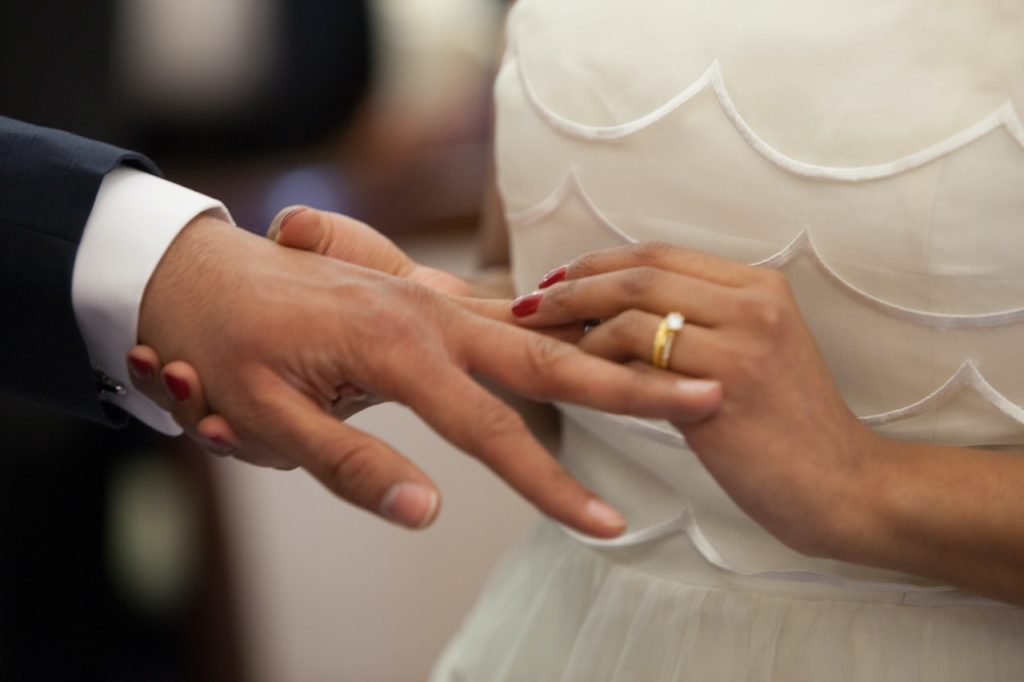
I learned this today. The first evidence for a wedding ceremony between a man and a woman is from Mesopotamia in 2350 BC.
In the time of hunter-gatherers, people lived in small groups, probably of about thirty people. Each group would have several male leaders who shared the women. They would all care for and raise the children.
Once people started to settle down and farm, about 12,000 years ago, they needed a more stable situation. The first evidence of a wedding ceremony comes from over 4,000 years ago, but the idea of marriage is probably much older.
The main reason for marriage was to bind a woman to a man so that the man could be sure that any children were his biological heirs. In many cultures, men were allowed multiple wives, but women were only allowed one husband, for this very reason.
The woman became the man’s property, and it was expected that she should bear children. If she didn’t, the groom could return her. The man was also the “owner” of his children, rather than just a father. He could deposit the children as collateral on a loan.
Another reason for marriage was strategic. It was a good way to tie people or groups of people together. Social groups would be more closely connected, and it would be easier to trade if there was a marriage between them.
Keeping alliances between families was also very important and anthropologists estimate that the majority of early marriages were either first or second cousin marriages.
When married, the woman moved away from her family and went to live with her husband’s family. Because of this, the traditions of dowry and bride price started. Dowry and bride price began in different cultures. A dowry was a sum of money or gifts that were given to the family of the bride to compensate them for the extra mouth they had to feed. A bride price was the money or gifts given to the family of the bride to compensate for the worker that was taken.
It is interesting that you can see the differences in technology and culture by looking at whether a place had a tradition of dowry or bride price. If the plough was extensively used, a dowry was common. This is because a plough is a labor-saving device and ploughing was usually done by men. Fewer workers were necessary, so women could do other work. The new husband would support her. In places that used a hoe instead of a plough, a bride price was paid. This is because hoeing is very labor intensive and both women and men hoed the land. A new bride would be one less worker in the family, so the husband’s family would compensate the bride’s family for the lost worker.
In the early days, a man could annul the marriage if there were no children, whether it was his fault or his wife’s. The bride price or the dowry would have to be repaid. However, the early Christian church decided that a marriage could no longer be annulled on the grounds of no children. The rapidly growing Roman Catholic Church also outlawed polygamy and made a requirement that a Roman Catholic priest had to attend a wedding.
In 1140, the Benedictine monk, Gratian, introduced the idea of consent into marriage. Up until this point, consent was not necessary for the union to go ahead. Gratian wrote a canon law textbook, Decretum, Gratiani, that said that both parties to the marriage had to give their verbal consent. That is where the “I do” started.
In 1563, the Council of Trent, formalized marriage as one of the seven sacraments and wrote it into canon law.
The marriage vows that are usually spoken today were written by Thomas Cranmer, Archbishop of Canterbury for Henry VIII, in his Book of Common Prayer, published in 1549. “To have and to hold from this day forward, for better, for worse, for richer, for poorer, in sickness, and in health, till death us depart.” This all comes from the Book of Common Prayer, and the wedding ceremony has barely changed in 500 years.
In the UK, in 1753, the Clandestine Marriage Act made it illegal to get married anywhere other than a church. This was the first time that the state had interfered in marriage on a public level. Then, in 1836, this law was changed to allow marriages in registry offices.
The idea of “love” doesn’t seem to have entered marriage until the Victorian age. Up until then it was seen as a contract. The Industrial Revolution changed society and old traditions were thrown out. The newly created middle class found the idea of marriage as a family decision distasteful. That tradition has carried on to today and has formed our views of marriage.
Incidentally, divorce was not really possible for most people before 1858 in the UK. In 1670, Parliament passed a law saying that divorce required an act of parliament for each and every case. There were only 300. In 1858, the law was changed, and divorce became possible, but it was still too expensive and difficult to prove. The 1969 Divorce Reform Act changed all that and introduced the divorce laws that we have today. And this is what I learned today.
Photo by Deesha Chandra from Pexels
Sources
https://www.bbc.com/news/magazine-17351133
https://www.incegd.com/en/news-insights/family-matrimonial-history-marriage
https://www.brides.com/history-of-marriage-2300616
https://www.livescience.com/37777-history-of-marriage.html
https://en.wikipedia.org/wiki/Marriage
https://ehistory.osu.edu/articles/marriage-ancient-mesopotamia-and-babylonia
https://en.wikipedia.org/wiki/Dowry
https://en.wikipedia.org/wiki/Bride_pricehttps://en.wikipedia.org/wiki/Book_of_Common_Prayer_(1549)
